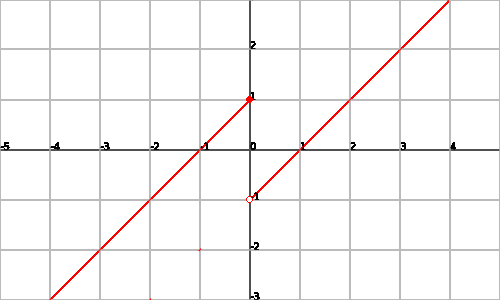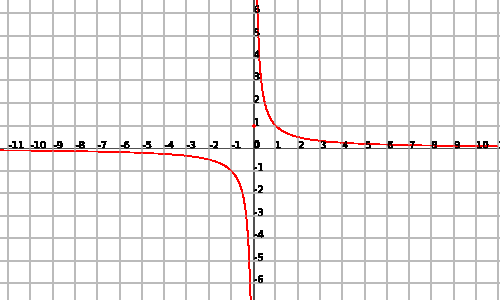The functions that are not continuous can present different types of discontinuities.
First, however, we will define a discontinuous function as any function that does not satisfy the definition of continuity. In other words, if we can find a point of discontinuity we will say that the function is not continuous:
Let's see an example of function that is not continuous:
Example
Let's take the function
This function is not continuous since at the point

It is necessary to bear in mind that a discontinuity is defined on points at the domain of a function. If the function was not defined in a point, although it has behavior similar to that of a discontinuity it would not be a discontinous function, since that would not have satisfied the definition given here.
Avoidable discontinuity
An avoidable discontinuity in a point
Let's see an example:
Example
Let's take the function
We can see quickly that at the point
Consequently,
Example
Let's take the function
We observe quickly that the subfunctions that define our function are continuous. Therefore the function will be continuous if its subfunctions match correctly. It can be seen that we have problems at point
Let's see what happens exactly:
Consequently,
Jump discontinuity
A function
If we denote this discontinuity with the name of "jump", it is also in contrast to the avoidable discontinuities. In this case we can not give the appropriate value to the discontinuity point since the side limits do not coincide. The following example will show clearly what we mean:
Example
Let's take the function
we can see that in the zero we have:
We can see the graphic representation of the function:

Example
Let's take the function
The function will be continuous at the point
Consequently, we have an jump discontinuity.
Essential discontinuity
A function
- The side limits do not coincide.
- Some of the side limits or both are infinity.
Let's see exactly every point:
- We might be in the previous case, inevitable discontinuity.
- But if we have :
In these cases we say that we have a vertical asymptote. For more on this issue it may be worth looking at the unit on graphic representation.
Let's see an example:
Example
Let's take the function
We can see a graphic representation of the function:

Attention! The function
We would have the discontinuity at the point
Nevertheless, the function has a vertical asymptote at
